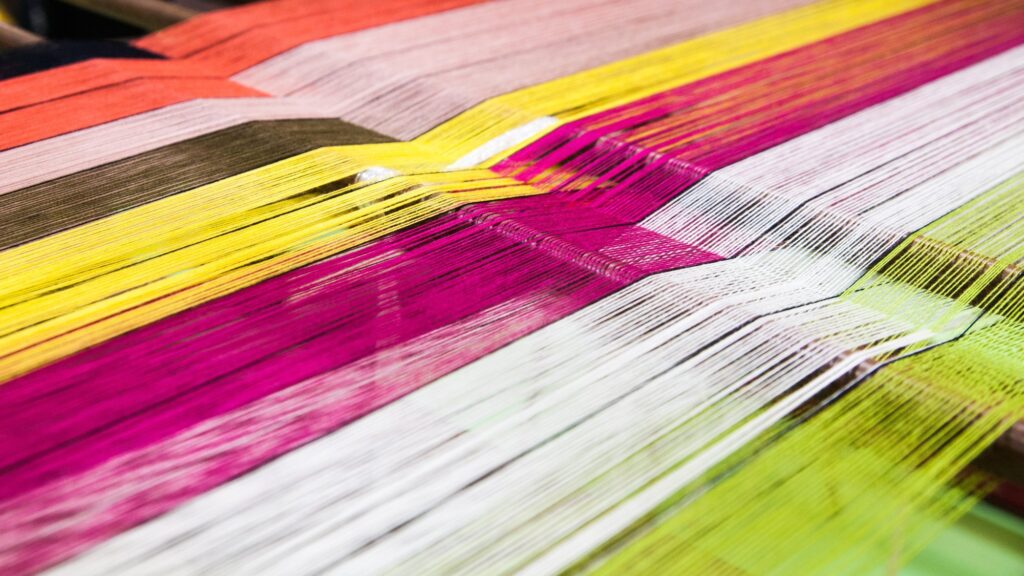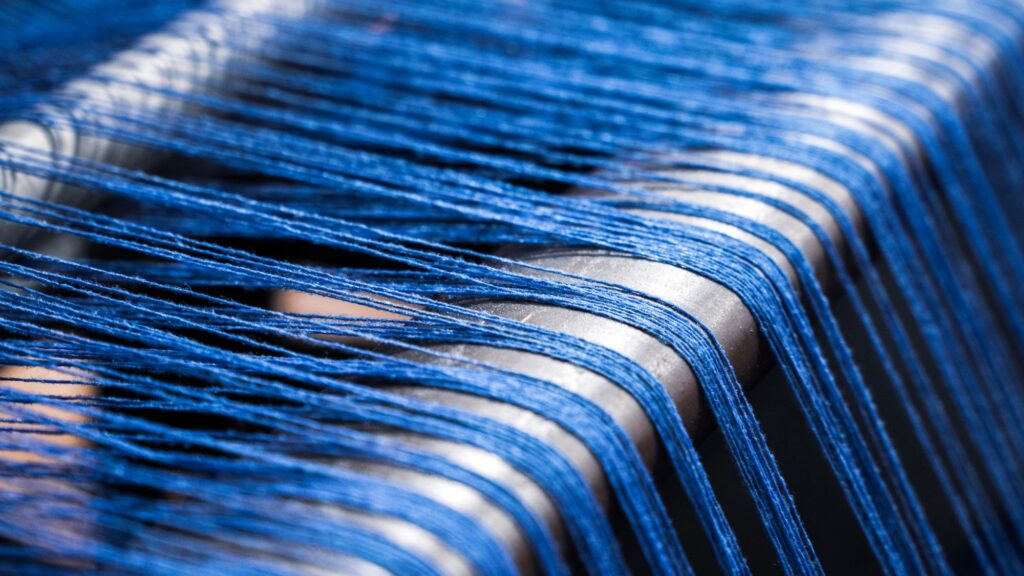Textile manufacturing runs on water—and plenty of it. Dyeing alone uses an estimated half-trillion gallons each year, enough to make the sector responsible for about 20 % of all industrial water pollution discharged worldwide. Fast-fashion demand accelerates the problem: the industry is now the planet’s second-largest consumer of water, with cotton shirts and denim among the thirstiest products in any wardrobe. Those rivers of wastewater often carry heavy-metal dyes and finishing chemicals into local ecosystems, harming wildlife and the communities that depend on the same water to drink and farm. healthymaterialslab.orgfairplanet.org
Water is only half the story; the other half is oil. Most new clothes are spun from synthetics made directly from fossil fuels—polyester alone accounts for roughly 57 % of all fiber produced today. Feeding that appetite takes real energy: current synthetic-fiber output burns through about 1.35 % of the world’s annual oil supply, more than the entire country of Spain uses in a year, and locks the resulting carbon into garments that will keep shedding micro-plastics for decades. Because fiber choice dictates both upstream resource use and downstream waste, swapping even a portion of virgin polyester or conventionally grown cotton for certified organic, recycled or closed-loop alternatives is one of the quickest ways a brand can cut emissions, water withdrawals and toxic runoff in a single move.
1. Organic Cotton
How it’s grown No synthetic pesticides or fertilizers. Farmers rely on crop rotation, compost and beneficial insects, so soils stay healthier and biodiversity rebounds.
Water & climate A recent Fairtrade life-cycle study found organic systems used 14 % less water and cut greenhouse-gas emissions 45 % per hectare versus conventional cotton.
Pros
- Natural, breathable, biodegradable
- Lower chemical runoff
- Big emission cuts possible with regenerative practices
Cons
- Yields are lower, so prices run higher
- Still thirsty compared with many bast fibers
- Certifications (GOTS, Fairtrade) are a must for credibility
GiftSpot take Our core tees use premium conventional cotton for softness, but we’re trial-printing GOTS-certified organic blanks now and aim to launch them in early 2026.

2. Recycled Polyester (RPET)
What it is: Fiber spun from PET bottles (and, with emerging tech, old garments). Mechanical recycling cuts energy use by roughly 59 % and CO₂ by around 32 % versus virgin polyester.
Pros
- Gives landfill-bound plastic a second life
- Strong, quick-drying, wrinkle-resistant
- Lower climate and energy burden than virgin synthetics
Cons
- All polyester—recycled or not—sheds micro-plastics in the wash
- Bottle-to-shirt systems can disrupt closed-loop bottle recycling
- Non-biodegradable at end-of-life
GiftSpot take We’re prototyping a 50/50 organic-cotton / RPET blend for moisture-wicking gym tees. We’ll publish micro-shed test data before launch.
3. Bamboo
The plant Fast-growing grass that needs little irrigation or pesticides, which sounds ideal—until processing begins.
Viscose reality Over 90 % of “bamboo” clothing is actually bamboo viscose, produced with carbon disulphide, sodium hydroxide and sulphuric acid; spills and worker exposure are well-documented hazards, and large-scale viscose drives deforestation.
Lyocell alternative Closed-loop bamboo lyocell recovers over 99 % of its solvent and uses far less water, making it the safer option—if the supply chain is transparent.
Pros
- Rapid renewability of the raw crop
- Soft hand and good drape
- Naturally antibacterial before heavy processing
Cons
- Viscose route is chemical-intensive and often green-washed
- Limited transparent supply of certified bamboo lyocell
- Not biodegradable if blended with synthetics
GiftSpot take Until we can source FSC-certified bamboo lyocell with full chain-of-custody proof, we’re steering clear of bamboo fabrics.
Quick comparison
| Factor | Organic Cotton | RPET | Bamboo (Viscose / Lyocell) |
|---|---|---|---|
| Pesticides | None | n/a | None on crop, heavy chemicals in viscose stage |
| Water use | Lower vs conventional cotton | Low | Low on farm; viscose processing is high |
| Carbon impact* | 40–45 % lower than conventional cotton | 30–70 % lower than virgin poly | Similar to viscose rayon; lyocell lower |
| End-of-life | Biodegradable | Non-biodegradable, recyclable in theory | Viscose biodegradable; lyocell biodegradable |
| Best for | Everyday comfort | Technical, quick-dry gear | Soft drape knits (lyocell) |
*Ranges reflect differing studies and regions.
How to choose
- Prioritize certifications: GOTS or Fairtrade for cotton, GRS for RPET, FSC plus closed-loop proof for bamboo lyocell.
- Match function to fiber: want stretch and quick-dry? RPET blends excel. Crave natural feel? Organic cotton wins. Need soft luxe drape? Certified bamboo lyocell.
- Care smart: wash cold, line-dry, and use a micro-fiber catch bag with synthetics.
- Ask brands hard questions: transparency beats buzzwords every time.
Where GiftSpot is headed
Beginning in Q4 2025, we’ll pilot micro-batch runs of GOTS-certified organic-cotton blanks. Small volumes let us fine-tune fit, colourfastness and print durability while keeping surplus fabric to a minimum. Limited drops also give customers a say—pre-orders help us match production to real demand, and every sell-out teaches us what to scale. By running these tests with regional cut-and-sew partners, we trim freight emissions and keep a closer eye on working conditions.
The insights from those trials feed directly into our 2026 roadmap. First up is a permanent Organic Collection: everyday tees and tanks made with 100 % certified organic cotton, transparent farm-to-factory tracing and third-party life-cycle data on every product page. Alongside it, we’ll launch an RPET Performance line built around fabrics containing at least 50 % recycled polyester. Our goal is to meet—or beat—the industry target of sourcing 45 % of polyester from recycled streams by 2025 and to push beyond bottle-to-shirt solutions toward true textile-to-textile recycling. Each style will undergo independent micro-fibre-shedding tests, with results published so shoppers can judge the trade-offs for themselves.
Sustainability doesn’t end when the shirt leaves our warehouse, so we’re switching all outbound packaging to 100 % recycled paper mailers printed with water-based ink. They’re curbside-recyclable, compostable in industrial facilities, and break down in months instead of centuries. Every mailer carries a QR code that links to digital care guides, repair tips and a take-back portal for end-of-life garments. For moisture-sensitive shipments we’ll use protective bags made from 100 % recycled LDPE—and invite customers to return them for closed-loop recycling.
Our promise is simple: shirts you love wearing, with impacts you can live with. We’ll publish an annual progress report so you can track how we’re doing and keep us honest.
- 2025 Q4: micro-batch runs of organic cotton blanks
- 2026: permanent Organic Collection and RPET Performance line
- Packaging: 100 % recycled paper mailers with on-pack care guides

